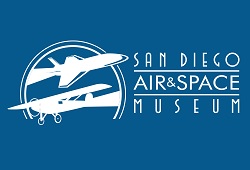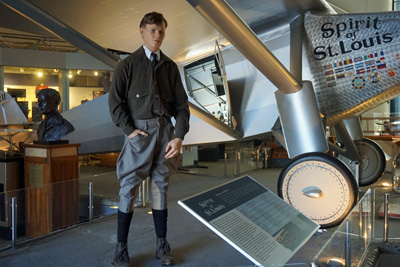
Humans have always had a fascination with flight. From Icarus of Greek mythology to the drawings of Leonardo da Vinci, the dream of flying goes back millenniums and finally reached fruition in 1903 when Oliver and Wilbur Wright achieved the previously impossible at Kitty Hawk, North Carolina. A mere sixty years later, humans were traveling into space and even to the moon. A remarkable accomplishment, and one that has been chronicled since 1963 at the San Diego Air & Space Museum in the city’s Balboa Park.
It is a fitting location. Early aviation pioneers John Montgomery and Glenn Curtiss – as well as aircraft manufacturers T. Claude Ryan and Reuben Fleet – were all based in San Diego during the early half of the twentieth century. When Charles Lindberg needed an aircraft that could fly cross the Atlantic Ocean without refueling, he turned to the Southern California locale, which lived up to its nickname as “Air Capital of the West.”
In 1961, a group of industry insiders and prominent businessmen decided to pay homage to the evolution of air travel, as well as the role San Diego played in its development. The corresponding San Diego Aerospace Museum opened on February 15, 1963, with a reproduction of the Curtiss A-1 (the Navy’s first seaplane), a 1929 Fleet Model 7, and the original rocket engine from the Bell X-1. As the collection grew, so did the number of visitors to the museum, and it wasn’t long before a new location was needed – not once but twice.
The Ford Building at Balboa Park was built for the Ford Motor Company’s exhibit at the 1935 California Pacific International Exposition. Designed by Walter Dorwin Teague, the facility is crafted in the Art Deco style prominent during that decade and features a large rotunda in the shape of a giant gear as its centerpiece. After a federal restoration grant was awarded for the structure in 1977, the city of San Diego approved the Aerospace Museum as the Ford Building’s new tenant.
Before the move could be completed, disaster struck when the museum’s previous home caught fire and destroyed the Aerospace Museum’s collection of aircrafts, artifacts, and archival documents. A recovery fund was quickly organized, and by the time the Aerospace Museum officially opened in the Ford Building on February 22, 1980, twenty-five planes were on display and a restoration facility constructed in the basement. From there, the Aerospace Museum once again grew, not only in regards to attendance but its collections, exhibits, and educational programs as well. Its reputation as one of the premier air and space museums in the United States increased as a result, and the Aerospace Museum officially became the San Diego Air & Space Museum in 2006.
Walking the museum offers a crash course on the history of flight. A model of Leonardo da Vinci’s ornithopter – meant to achieve flight through flappable wings – is on display, as well as a model of the Montgolfier balloon, the world’s first hot air balloon. In 1852, Sir George Caley constructed a single-wing craft that enabled a human to glide through the air. The concept was improved afterwards by other aeronautic engineers, all of which are likewise honored at the museum.
Two of those engineers were Oliver and Wilbur Wright. In 1902, the brothers test flew their third glider, which included a rudder for better control. By the end of the year, the Wright Glider had set records for distance (622 feet), time aloft (90 seconds), and most flights (over 700). It is considered the world’s first practical aircraft and paved the way for a successful powered glider in 1903. A replica of the 1902 Wright Glider is on display at the San Diego Air & Space Museum.
Although the Wright Brothers continued to finetune their aircraft, it wasn’t long before other aviation afficionados were not only duplicating their feats but exceeding them as well. In 1909, for instance, Louis Bleriot flew his Bleriot XI across the English Channel, and the craft briefly became the standard before being eclipsed by other designers. Racing planes emerged during the time period as well, including the Deperdussin 1911, which won the Golden Bennett Trophy in 1912 and was the first aircraft to travel faster than 100 miles per hour. A reconstructed Bleriot and actual Deperdussin are also part of the Air & Space Museum’s collection.
While both World War I and World War II accelerated aircraft designs and engineering, the solo flight across the Atlantic Ocean by Charles Lindberg in 1927 is arguably the greatest achievement of the era. Lindberg made the flight from New York City to Paris in 33 hours and 30 minutes in a plane designed, built, and tested in San Diego. Since financial backing for both the craft and Lindberg’s flight came from St. Louis, however, it was named the Spirit of St. Louis. Four months after his historic flight, Charles Lindberg flew the Spirit of St. Louis to San Diego, where 60,000 residents crammed Balboa Stadium to welcome back both the pilot and the plane.
Initially the reciprocating engine and propeller were the only functioning methods to achieve flight. That changed in the mid-1930s when Sir Frank Whittle of England created the world’s first gas turban engine, which was then perfected by Germany during World War II. The United States began development on its own jet propulsion system near the end of the war. By the mid-1950s, the U.S. Air Force fully utilized jet propulsion rather than reciprocating engines. The invention also led to an increase in commercial air travel.
Having conquered the air, it wasn’t long before humans looked to conquer space as well. For that leap, a rocket rather than plane was required. It is believed that the Chinese were using black powder to ignite fireworks by the year 600, and even perfected primitive rockets for warfare by 1300. Russian science fiction writer Konstantin Tsiolkovsky developed the basics of rocket propulsion in 1903, while American Robert Goddard and German Hermann Oberth built upon Tsiolkovsky’s work in the 1920s and 1930s. Germany further perfected rocket propulsion during World War II with their V-2 ballistic missiles.
After the Soviet Union launched the first artificial satellite – named Sputnik – in 1957, a Cold War Space Race between the Soviets and United States erupted. The Soviets again surged ahead in that race when cosmonaut Yuri Gagarin became the first human to not only travel into space but also complete a full orbit of planet Earth. President John F. Kennedy responded by challenging the United States to place a man on the moon by the end of the 1960s. A succession of space programs came fast and furious afterwards, from the one person Mercury to the two person Gemini to the three person Apollo. Then on July 20, 1969, astronauts Neil Armstrong and Buzz Aldrin stepped foot on the lunar surface.
The San Diego Air & Space Museum pays homage to American space efforts during the 1960s, with models of the Mercury, Gemini, and Apollo capsules all on display. The highlight, however, is the actual Apollo 9 capsule flown by astronauts Jim McDivitt, Dave Scott, and Rusty Schweickart. It was during Apollo 9 that the lunar module was first tested in space, with successful docking and undocking procedures performed during the flight. The Apollo 9 capsule was originally exhibited at the Michigan Space and Science Center before being relocated to San Diego in 2004.
Oliver and Wilbur Wright made their first successful flight on December 17, 1903. Neil Armstrong and Buzz Aldrin walked on the moon on July 20, 1969. The quest to fly may extend back millenniums, but in a short 66-year timespan the dream of airflight was not only achieved but spaceflight as well. The San Diego Air & Space Museum honors both ends of that spectrum, and likewise traces the arc that lies in-between. The museum is thus more than a museum but a monument to the men and women who made flight possible.
Anthony Letizia





